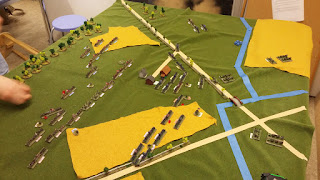 |
| My Goblin army for the day |
Here's a rundown of the rules to anyone with Lion Rampant wondering what's changed:
- Virtually all game rules are the same
- Restrictions on army composition regarding unit types have been lifted
- Additional special rules for flying, magic and undeath
- New scenarios
- Some new unit types to fit the fantasy theme, such as lesser and greater warbeasts
- Suggested "army lists" for different fantasy races but something you are free to mix, match and reinterpret.
- Rules for "reduced model units" and "single model units" which enables players to use multi-wound monsters to represent that 12 model group (just like we did in our previous Lion Rampant game).
| The opposing armies approach each other |
Basically it's a repackaged minor modification of the Lion Rampant rules, but it is easy to justify the purchase as the rules are cheap. On top of the rules mods, there's plenty of beautiful fantasy artwork as you would expect from Osprey. They've really stepped up on the wargames market!
For the uninitiated, here's a summary on how the rules work:
- During a turn you roll to activate your units to either move, shoot or fight. Depending on the units, some actions are more difficult to pull off than others.
- When you fail an activation, or when you've activated everyone, the turn is passed to your opponent.
- When moving, no model may move faster than their limit, units must remain within 3" of their unit leader and no model may go closer than 3" of models belonging to other units unless attacking. There's speed reduction for terrain but no wheeling, formations etc.
- Shooting and combat is as simple as it gets. Check ranges, roll a bucket of dice and remove casualties. Morale tests for all units losing models. Those tests are easy to pass initially, but every lost model makes it harder to pass.
- As each unit activation is completed individually, there's no multi unit combat. Which is kind of a bummer because this means there are no real flank/rear attacks either. This is one of the few gripes I have with the rules. Another thing is that games tend to run for some turns after the winner is already clear. The game takes some two hours to play however so don't worry.
- Fighting in terrain makes troops of differing quality equal. Those heavy infantry troops can be fought off by peasants and so on. This is a novel idea which gives players good incentive to include some cannon fodder into their lists as they become more cost effective in terrain. There are unit types which ignore the terrain penalties however.
- The basic recipe gets shaken up by plenty of different scenarios and a "glory system" where players have additional objectives they try to accomplish.
After just two games with the "rampant" system it's still early to draw any conclusions but I'd give these rules three-and-a-half stars out of five at the moment. The rules are quite tactical but also really light and I'm sure there are a lot of games decided by lucky rolls of the dice instead of superior tactics. The main draw of the game is to enable players to put pretty much any models they have on the table again and have a light hearted game with their friends. If marketed properly, I don't see any reason why this set of rules wouldn't enjoy the same kind of success Frostgrave has.
Oh, here are some photos of the game. My orcs were soundly beaten by the Marauders of the North.
 |
| Marauder infantry, counts as heavy foot |
| A greater warbeast attacks the bellicose orcs in the woods. |
 |
| The warbeast is on the rampage |
| The orcs find themselves enveloped on both flanks! |
 |
| With the "no movement within 3" of other units" rule, squeezing you unit through your own line can be surprisingly hard. |
 |
| The warbeast is brought low by the Goblin general and his bodyguard. |
| Scouts are quite good at shooting. Not so good at defending against Elite foot. |
 |
| The giant (elite foot, single model unit) is charged by heavy cavalry and is killed after a bit of to-and-fro combat. |
| The goblin general is slain by his opposite number. |
| The last goblins (light infantry) form a spearwall and start throwing javelins at anyone coming too close. It's time to concede defeat. |














































